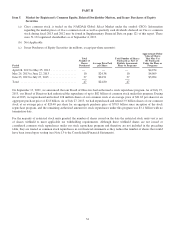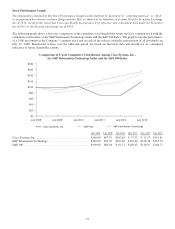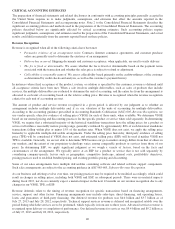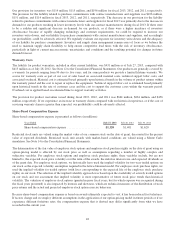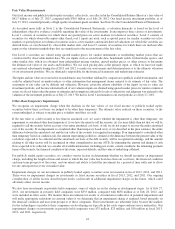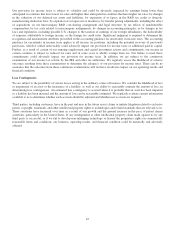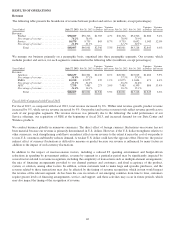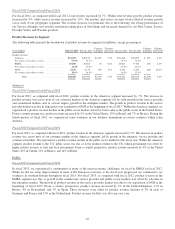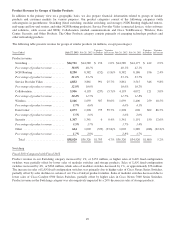Cisco 2013 Annual Report Download - page 52
Download and view the complete annual report
Please find page 52 of the 2013 Cisco annual report below. You can navigate through the pages in the report by either clicking on the pages listed below, or by using the keyword search tool below to find specific information within the annual report.Goodwill and Purchased Intangible Asset Impairments
Our methodology for allocating the purchase price relating to purchase acquisitions is determined through established
valuation techniques. Goodwill represents a residual value as of the acquisition date, which in most cases results in measuring
goodwill as an excess of the purchase consideration transferred plus the fair value of any noncontrolling interest in the
acquired company over the fair value of net assets acquired, including contingent consideration. We perform goodwill
impairment tests on an annual basis in the fourth fiscal quarter and between annual tests in certain circumstances for each
reporting unit. The assessment of fair value for goodwill and purchased intangible assets is based on factors that market
participants would use in an orderly transaction in accordance with the new accounting guidance for the fair value
measurement of nonfinancial assets.
The goodwill recorded in the Consolidated Balance Sheets as of July 27, 2013 and July 28, 2012 was $21.9 billion and $17.0
billion, respectively. The increase in goodwill for fiscal 2013 was due in large part to our acquisitions of NDS and Meraki. In
response to changes in industry and market conditions, we could be required to strategically realign our resources and consider
restructuring, disposing of, or otherwise exiting businesses, which could result in an impairment of goodwill. There was no
impairment of goodwill resulting from our annual impairment testing in fiscal 2013, 2012, and 2011. For the annual
impairment testing in fiscal 2013, the excess of the fair value over the carrying value for each of our reporting units was $38.7
billion for the Americas, $15.5 billion for EMEA, and $17.8 billion for APJC. We performed a sensitivity analysis for
goodwill impairment with respect to each of our respective reporting units and determined that a hypothetical 10% decline in
the fair value of each reporting unit as of July 27, 2013 would not result in an impairment of goodwill for any reporting unit.
We make judgments about the recoverability of purchased intangible assets with finite lives whenever events or changes in
circumstances indicate that an impairment may exist. Recoverability of purchased intangible assets with finite lives is
measured by comparing the carrying amount of the asset to the future undiscounted cash flows the asset is expected to
generate. We review indefinite-lived intangible assets for impairment annually or whenever events or changes in
circumstances indicate the carrying value may not be recoverable. Recoverability of indefinite-lived intangible assets is
measured by comparing the carrying amount of the asset to the future discounted cash flows the asset is expected to generate.
If the asset is considered to be impaired, the amount of any impairment is measured as the difference between the carrying
value and the fair value of the impaired asset. Assumptions and estimates about future values and remaining useful lives of our
purchased intangible assets are complex and subjective. They can be affected by a variety of factors, including external factors
such as industry and economic trends, and internal factors such as changes in our business strategy and our internal forecasts.
There was no impairment charge related to purchased intangible assets during fiscal 2013. Our impairment charges related to
purchased intangible assets were $12 million and $164 million during fiscal 2012 and 2011, respectively. Our ongoing
consideration of all the factors described previously could result in additional impairment charges in the future, which could
adversely affect our net income.
Income Taxes
We are subject to income taxes in the United States and numerous foreign jurisdictions. Our effective tax rates differ from the
statutory rate, primarily due to the tax impact of state taxes, foreign operations, R&D tax credits, domestic manufacturing
deductions, tax audit settlements, nondeductible compensation, international realignments, and transfer pricing adjustments.
Our effective tax rate was 11.1%, 20.8%, and 17.1% in fiscal 2013, 2012, and 2011, respectively.
Significant judgment is required in evaluating our uncertain tax positions and determining our provision for income taxes.
Although we believe our reserves are reasonable, no assurance can be given that the final tax outcome of these matters will not
be different from that which is reflected in our historical income tax provisions and accruals. We adjust these reserves in light
of changing facts and circumstances, such as the closing of a tax audit or the refinement of an estimate. To the extent that the
final tax outcome of these matters is different than the amounts recorded, such differences will impact the provision for
income taxes in the period in which such determination is made. The provision for income taxes includes the impact of reserve
provisions and changes to reserves that are considered appropriate, as well as the related net interest and penalties.
Significant judgment is also required in determining any valuation allowance recorded against deferred tax assets. In assessing
the need for a valuation allowance, we consider all available evidence, including past operating results, estimates of future
taxable income, and the feasibility of tax planning strategies. In the event that we change our determination as to the amount of
deferred tax assets that can be realized, we will adjust our valuation allowance with a corresponding impact to the provision
for income taxes in the period in which such determination is made.
44


